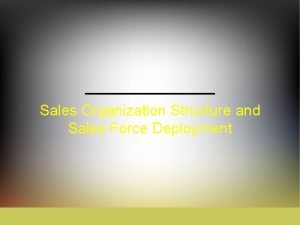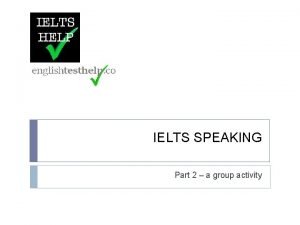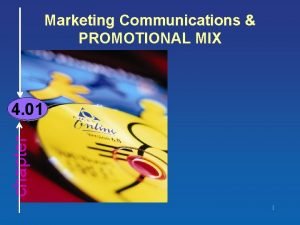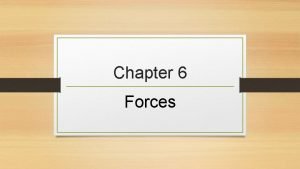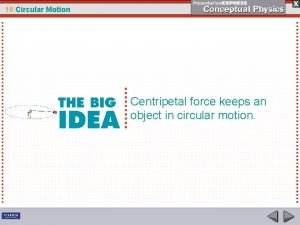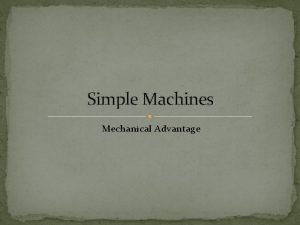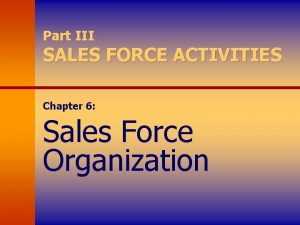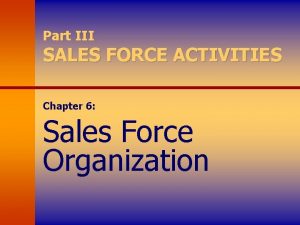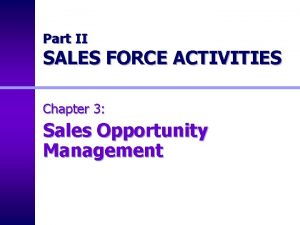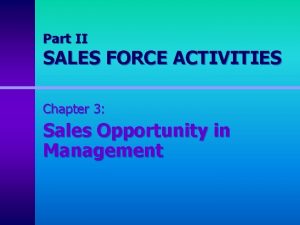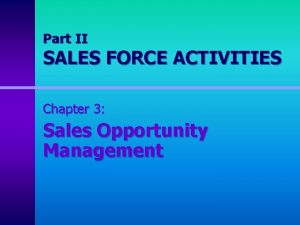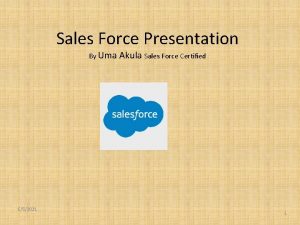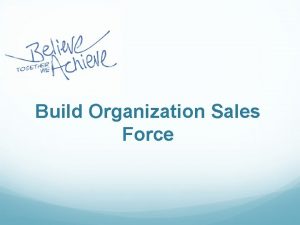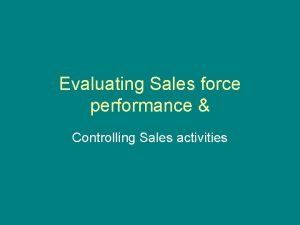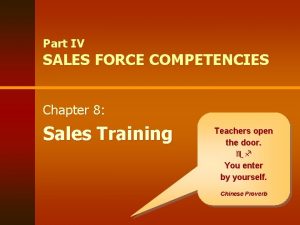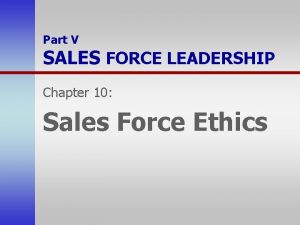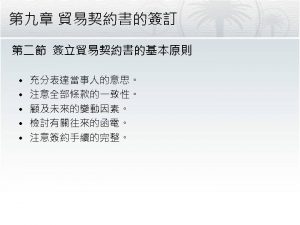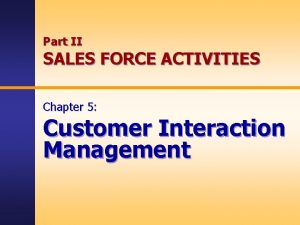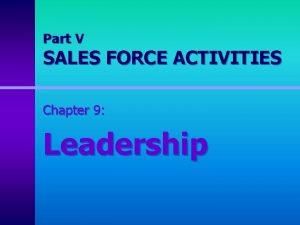Part III SALES FORCE ACTIVITIES Chapter 6 Sales




















- Slides: 20

Part III SALES FORCE ACTIVITIES Chapter 6: Sales Force Organization

Sales Force Organization: Impact Structure Sales Management Role Compensation Recruiting/ Selection Training Program Performance Evaluation Figure 6 -1: Decisions Affected by Sales Force Organization

Sales Force Organization: Topics Sales Force Specialization Strategic Account Management Telemarketing Independent Agents Emerging Issues

Strategic Account Programs: Survey Results 49% Today In Five Years 45% 24% 18% 20% 17% 16% 11% Customer Generalist Product Lines Functional Figure 6 -2: How Sales Forces are Organized

Sales Force Organization: Generalist National Sales Manager Central Regional Sales Manager Eastern Regional Sales Manager Western Regional Sales Manager Northeast District Sales Manager Mid-Atlantic District Sales Manager Southern District Sales Manager Connecticut Rhode Island Maine Vermont New York Massachus etts New York New Jersey Pennsylvania North Carolina South Carolina Delaware District of Columbia Georgia Alabama Virginia Maryland Mississippi Florida Figure 6 -3: Geographical Sales Organization

Sales Force Organization: Product Specialists National Sales Manager Eastern Regional Sales Manager Northeast District Sales Manager Printer Equipment Salesperson Server Salesperson Mid-Atlantic District Sales Manager Minicomputer Salesperson Programmable Calculator Salesperson Southern District Sales Manager Copier Salesperson Large Computer Salesperson Figure 6 -4: Product Specialized Sales Force

Product Specialist Organization: Analysis § Advantages - Allows focusing of sales effort - Expertise developed in limited number of products § Disadvantages - More expensive to operate - May result in duplication of sales calls to clients

Sales Force Organization: Customer Specialists National Sales Manager National Accounts Manager Northeast District Sales Manager Salesperson For Educational Institutions Manager of Export Sales Eastern Regional Sales Manager Mid-Atlantic District Sales Manager Salesperson for Retail Customers Salesperson for Manufacturers Southern District Sales Manager Salesperson for Government Agencies Salesperson for Bank Customers Salesperson for Wholesale Customers Figure 6 -5: Customer Specialized Sales Force

Customer Specialist Organization: Analysis § Advantages - Consistent with market driven strategy - Salespeople become customer experts - Customer segments receive appropriate resources § Disadvantages - May conflict with marketing organization - Product expertise may be lacking - More expensive

Sales Force Organization: Functional Specialists Division Marketing Manager Industry Sales Manager Account Executives (Salespeople) Systems Manager Administrative Manager System Reps Market Administrative (Technical Support) (Training & Installation) Figure 6 -6: Functional Specialization

Organizational Structure Advantages Disadvantages Generalist (Geographic) • Low cost • No geographic overlap • No customer overlap • Limited product line knowledge • Limited customer knowledge • Lack of management control over product or customer emphasis Product • Product knowledge • Control over product emphasis • Low geographic efficiency • Customer duplication • Geographic duplication Customer • Deeper customer knowledge • Control over customer emphasis • High cost • Less product knowledge • More geographic duplication • Difficult coordination with product managers Functional • Effectiveness in performing selling activities • Coordination • Geographic duplication • Customer duplication Figure 6 -7: Comparing Sales Organization Structures

Strategic Accounts: What is Different about Strategic Accounts? Previous Approach Bsiness Plan § 3 – 6 months Duration Structure of § Tactical Business Plan promotional program Personnel § Sales reps and Involvement purchasing agents New Strategic Account § 2 – 3 years § Strategic business plan focused on growth and profitability § Senior management from both companies Figure 6 -8 : Changes in Joint Account Planning

Strategic Accounts: Alternative Organization Models § Existing Sales Force - Low risk; little change § Management Sell National Accounts - Keeps management close to customer § Separate Sales Force - More aggressive; more expensive; alternative to sales management for promotion for sales staff § Sales Teams - Use when selling process is complex

Field Rep Telemarketing Sales calls per day 5 25 Sales calls per quarter 325 1, 624 Sales calls per year 1, 300 6, 500 Salespeople required 6. 5 1. 2 Cost per sales call $250 $15 Cost per year $1, 998, 750 $117, 000 Table 6 -1: Doing the Math on Account Management

Sales Force Organization: Scope of Telemarketing Activity Description Customer Service § Companies provide customers with a number they can call if they have questions. Prospecting and Lead Qualification § Firms are taking a proactive approach to prospecting by having telemarketers call prospects or qualify them for face-to-face selling. Account Management § Selling secondary product lines or service small customers by phone, thereby freeing their salespeople to concentrate on larger customers and strategic product lines. Promotion Support § Develop newspaper and magazine ads that feature either a local or an 800 number to get additional product information or place an order. Figure 6 -9: The Scope of Telemarketing Activities

Sales Force Organization: Telemarketing Advantages and Challenges Advantages § Low cost per sales call § Profitably serve small to medium customers § Speed/time saving of telephone ordering Challenges § Acceptance by field salespeople § Management § Role of the Internet

Sales Force Organization: Economic Analysis of Sales Agents Independent Agents Total Selling Costs Own Sales Force Break-Even Sales Volume Figure 6 -10: Total Costs of Independent Agents vs. Own Sales Force

Sales Force Organization: Market Conditions Favoring Sales Agents § The market is fragmented and customers are difficult to find or understand. § The products are easily understood commodities that have been around for a long time. § Buying is decentralized. § Local knowledge and local distribution is important. § The selling cycle is short and orders are typically small. § The company is selling only a few products. § It is not necessary to tightly control the selling effort. § There is a good potential sales agency who has significant marketing expertise in the industry. § Ongoing support activities are not important and the company does not need customer information. § The company is not well known and has little equity in the market. Figure 6 -11: Market Factors Favoring the Use of Sales Agents

Customer Awareness Brand Consideration Marketing Brand Preference Handoff Purchase Intent Purchase Sales Customer Loyalty Customer Advocacy Figure 6 -12: The Marketing-Sales Handoff

Sales Force Organization: Key Account Sales Teams at Ericsson Country President V. P. Business Operations Key Account Team Sales Director of Operations Director Product Support Global Accounts Director Account Managers Project Managers Product Managers Account Coordinators Technical Support Engineers Account Coordinators Figure 6 -13: Sales Team Organization at Ericsson
 Territorial sales force structure example
Territorial sales force structure example Sales organization structure and sales force deployment
Sales organization structure and sales force deployment Hamlet act iii scene ii
Hamlet act iii scene ii Va handbook 5017 employee recognition and awards
Va handbook 5017 employee recognition and awards Operating activities vs investing activities
Operating activities vs investing activities Outdoor and indoor sports
Outdoor and indoor sports Support activities and primary activities
Support activities and primary activities Examples of primary activities
Examples of primary activities Ielts speaking group
Ielts speaking group 4 types of promotion mix
4 types of promotion mix Contact and noncontact forces
Contact and noncontact forces Vt=2pir/t
Vt=2pir/t Contact vs long range force
Contact vs long range force If you whirl a tin can on the end of a string
If you whirl a tin can on the end of a string Advantage
Advantage What is net force
What is net force Centrifugal force ap human geography
Centrifugal force ap human geography Noncontact force definition
Noncontact force definition Is electric force a conservative force
Is electric force a conservative force Centripetal force and gravitational force
Centripetal force and gravitational force Hooke's law vector form
Hooke's law vector form

